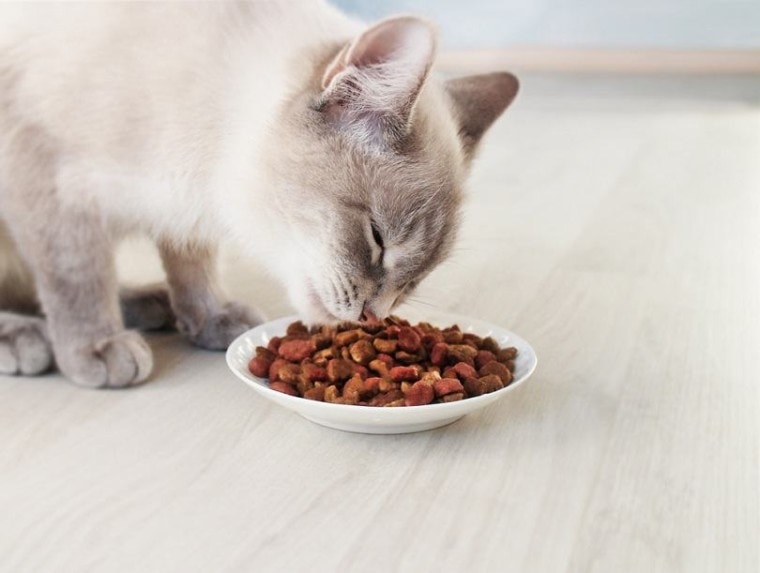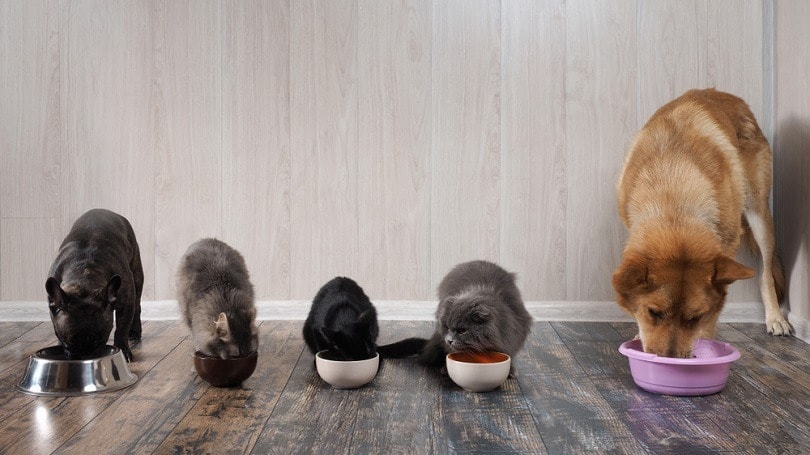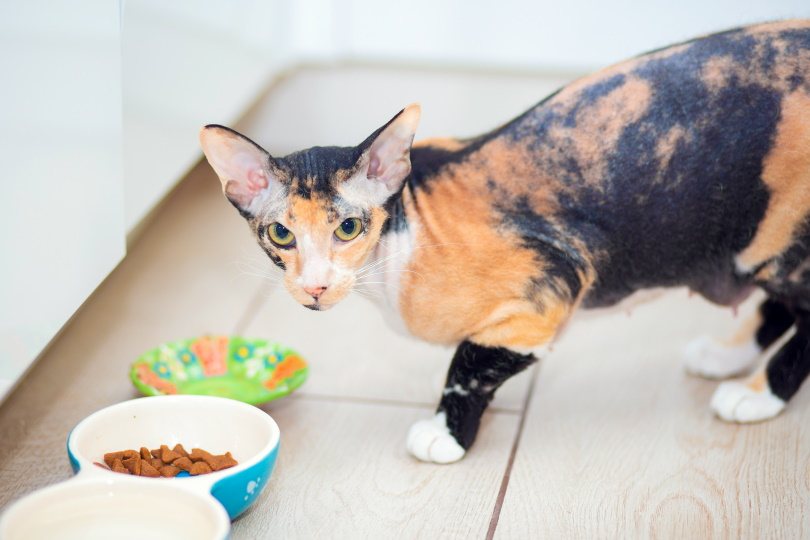
Meal feeding, free feeding, and combination feeding are the three main methods of feeding a cat. Free feeding means leaving dry food out at all times so your cat can grab a bite whenever they feel hungry. Meal feeding means feeding wet, dry, or a combination of both food types on a predetermined schedule. Combination feeding typically means that you leave dry food down at all times and feed wet food on a schedule, usually once or twice a day. There are benefits and pitfalls to each method.
What Is Meal Feeding?
Feeding cats on a schedule, or meal feeding, means serving wet, dry, or a combination of food types to your cat at strict meal times. This feeding schedule means cats might beg for food between meals, and once they learn the schedule, they will be inclined to let you know when you’re late. A schedule for your cat also means a schedule for you, and too great a deviance from mealtimes could prove unhealthy for your cat.

Top 5 Benefits of Meal Feeding
While there are a few drawbacks to a meal-feeding schedule, there are several advantages.
1. Give Medications More Easily
From kittens to seniors, many cats need to take medications and supplements. As a pet parent, you must ensure that they get the right amount of medicine at the right time. Free feeding means you must place a certain degree of trust in your cat—a species that is notorious for being able to detect pills among mouthfuls of food and spitting them out.
By sticking to a timetable and feeding on a schedule, you ensure that your cat will eat all or most of their meal in one go. You can watch to ensure that they don’t locate and remove tablets, powders, and other medications.
Feeding on a schedule also enables you to better spread out medication. If you put medication on your cat’s kibble in the morning, they may only eat them later in the day and just before you provide more. That means your cat could be getting no medication in the morning and doubling up in the evening. This is not effective and can even put your kitty’s life at risk. So, this practice should be avoided. If you need to give your cat their medication at a certain time, you must guarantee that they get it.
2. Control Food Intake
Similarly, you can manage the amount of food that your cat eats and when. Free feeding can lead to overeating because it is tricky to monitor the exact amount of food that you provide. It is easy to just put another handful of kibble in the bowl when you’re in a hurry to get out of the house and forget about this supplemental feeding later.
Cats are prone to obesity and can easily put on weight. The relatively small size of a cat means it only takes a small increase in their daily calories to lead to weight gain.
By feeding them two or three meals a day, it is easy to calculate a daily allowance and then break this down into set meal sizes. More importantly, it is easier to know exactly how much you have fed them and ensure that you stick to the plan.
- NO MESS - The 360° tray on this cat food and water bowl set has a raised design to catch and...
- WHISKER FRIENDLY - Shallow and wide metal containers with flat bottoms ensure your kitty can enjoy...
- CHEW-SAFE MATERIALS - Kittens and cats love chewing on silicone and soft rubber - but it's a choking...
High-quality cat food is an important part of fostering a long and healthy life for your cat but the right cat food and water dish will promote good posture, offer whisker relief, and aid in good digestion. The Hepper NomNom Cat Bowl is our favorite bowl since it offers all of the above and is beautifully crafted to meet modern home stylings. The wide tray design catches any food and water spills and the entire setup is dishwasher safe. Learn more about the Hepper NomNom Cat Bowl here.
At Pet Keen, we’ve admired Hepper for many years and decided to take a controlling ownership interest so that we could benefit from the outstanding designs of this cool cat company!
3. Check Appetite Changes
Appetite can tell us much about a cat’s health and well-being. If your cat is eating substantially more or less than usual, it could be a sign that something has changed. Illnesses tend to cause cats to lose their appetite, especially if the illness affects your cat’s mouth or digestive system. That said, certain conditions, such as feline dementia, may mean your cat eats more because they forget that they have already eaten.
Since you can easily track the amount that you are feeding them and know how much your cat ingested, scheduled meal times enable you to better gauge your cat’s appetite. You can see whether your feline friend is eating less or if they seem hungry and will need extra calories because they are losing weight. Scheduled feeding enables you to keep an eye on their feeding levels over time.
4. Prevent Mealtime Dominance
When you free feed in a multi-cat household, it is difficult to know exactly how much one cat is eating compared to another.
Your pack may look like they share well when you are standing over them, but as soon as you walk away, one cat may become the dominant force around the food bowl. This dominance doesn’t necessarily mean physical bullying, so it can be hard to detect. One cat may walk away while suffering inappetence, leaving your other cats to eat more than their fair share, and you likely won’t even notice.
A feeding schedule enables you to better watch over your cats and feed them in different locations. Keep your cats apart until they’ve finished eating, and you can prevent dominance over food.

5. Get Into a Routine
A feeding schedule provides a routine for your cat, which can help you develop your own routine. Your outdoor cat, for example, will know to come home in time for dinner, which means you can get your cat indoors before it gets dark.
Just be careful about how soon you feed them breakfast. If you give it to them as soon as you wake up, you may find that your cat encourages you to wake up earlier just to feed them.
 The Drawbacks of Free Feeding
The Drawbacks of Free Feeding
Free feeding requires that you carefully measure the amount of dry food that you put out, and you will need to track how many bowls or cups your cat eats. When free feeding, it is easy to overfeed, and this can cause your cat to become overweight or obese. This, in turn, leads to a greater likelihood of illnesses like diabetes. Families with more than one cat may also find it difficult to discern which cat is eating how much of the food.

Combination Feeding Drawbacks
Combination feeding can offer greater variety in your cat’s diet while ensuring that your cat gets the moisture that is only really present in wet food. However, if your cats greatly prefer wet food, they may ignore the dry food that you put down, which means your cats may not be getting all the nutrition that they are supposed to. You may have to relent and revert to offering entirely wet food meals.
Similar to free feeding, combination feeding can lead to overfeeding unless you carefully monitor food levels. This feeding method also makes it difficult to determine which of your cats is eating how much of their food.
Free Feeding vs. Scheduled Feeding for Cats

How Often Should You Feed Your Cat?
There are benefits to each feeding method, but if you decide that feeding on a schedule is the right choice for you, you will need to develop a workable schedule and ensure that you’re feeding your cat the right amounts.
Ideally, you should feed your cat more than once or twice a day. If you can feed them four meals at consistent intervals, that is ideal, but three is also suitable. If you go to work, feed them in the morning, when you get home from work, and in the evening, or use an automatic feeder that will deploy meals at a given time each day.
Automatic Feeders
Automatic feeders can be beneficial if you aren’t at home all day. You place the food in the feeder and set the time that you want the food to be given, and the machine will uncover the food or serve it at that time. Whether you’re at work and unable to serve meals or you’re at home but want to ensure consistency, the feeder can take up the feline-feeding mantle on your behalf.
How Much Should You Feed Your Cat?
Ideally, you should use a cat calorie calculator and body condition score to determine your cat’s daily caloric needs. Once you know how many calories your cat should have per day, check their food packets to determine how many calories per cup they provide. Consult with your veterinarian if your cat has any illnesses or health conditions or if they are over- or underweight, to ensure that you’re feeding them the right amount of food.
Find here our useful tool to calculate your cat calories and proportions:
The exact amount of calories an individual animal needs to maintain a healthy weight is variable and influenced by many factors including genetics, age, breed, and activity level. This tool is meant to be used only as a guideline for healthy individuals and does not substitute veterinary advice
Final Thoughts
There are several methods of feeding a cat that can be beneficial to felines and their owners. Free feeding is popular but can lead to overfeeding, which is also a problem with combination feeding.
Scheduled feeding, or meal feeding, enables you to accurately determine how much food you do give and makes it easier to monitor intake, give medications, and provide a regular schedule for your cat. Ensure that you feed them an appropriate amount, and be prepared to stick to a rigorous schedule, as your cat will be expecting food at the same time every day.
Featured Image Credit: catinrocket, Shutterstock




 The Drawbacks of Free Feeding
The Drawbacks of Free Feeding



